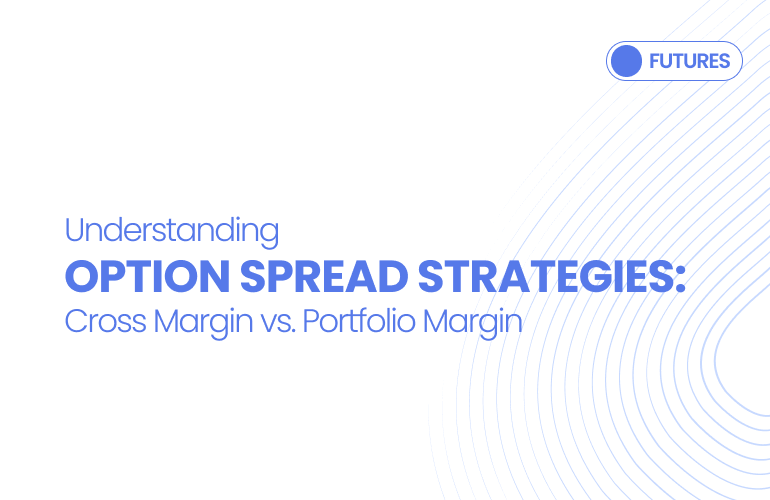When trading option spreads, understanding how different margin modes affect your capital efficiency is essential. Let’s explore the differences between Cross Margin and Portfolio Margin using a Bear Put Spread as an example.
Bear Put Spread Example
Imagine Bitcoin (BTC) is trading at $20,250. A trader executes the following trades:
| Contracts | Qty | Entry Price | Mark Price |
| BTC-22JUL22-18500-P | −1 | 280 | 290 |
| BTC-22JUL22-20000-P | 1 | 760 | 750 |
Let’s take a look at the difference between the maintenance margin required by trading the same investment portfolio in the cross margin and portfolio margin modes.
Cross Margin Mode
In the cross-margin mode, traders need to pay premiums for buying Options, while a seller of Options can receive the premium paid by the buyer. However, the seller’s USDC Derivatives account will be occupied with the corresponding margin.
| Contracts | Direction | Premium | Maintenance Margin Required |
| BTC-22JUL22-18500-P | Sell | −280 USDC | 2,315 USDC* |
| BTC-22JUL22-20000-P | Buy | 760 USDC | – |
*The maintenance margin required to sell BTC-22JUL22-18500-P is calculated as follows:
Position MM = [Maximum (0.03 × 20,250, 0.03 × 290) + 290 + 0.2 % × 20,250] × 1 = 938 USDC
Position IM = Maximum [(Maximum (0.15 × 20,250 − (20,250 − 18,500), 0.1 × 20,250) + Maximum (280, 290) × 1), Position MM] = 2,315 USDC
The total occupied initial margin in cross margin mode is 2,315 USDC. Therefore, when a trader uses a spread strategy to trade Options in the cross margin, the funds occupied are often close to the margin pledged by selling Options.
Portfolio Margin Mode
Under the Portfolio Margin, the required maintenance margin is calculated based on the Maximum Loss and Contingency Component.
- The Risk Parameter, Preset Price Range of Underlying and the Preset Volatility Percentage of each Option are displayed in the table below:
| BTC-Options | ETH-Options | |
| Risk Parameter | 15% | 15% |
| Preset Price Range | (0, ± 3%, ± 6%, ±9%, ±12%, ±15%) | (0, ±3%, ±6%, ±9%, ±12%, ±15%) |
| Preset Volatility Percentage | (-28%, 0%, 33%) | (-28%, 0%, 33%) |
Taking BTC-Options as an example, let’s take a look at the profit and loss for the preset 33 scenarios.
| Preset Price % and Preset Volatility % | Total P&L | BTC-22JUL22-18500-P | BTC-22JUL22-20000-P |
| -15% ( −28%, 0%, 33%) | 625.7977 | −1,684.48 | 2,310.27 |
| 963.6231 | −1,087.65 | 2,051.27 | |
| 782.9313 | −1,335.70 | 2,118.63 | |
| −12% ( −28%, 0%, 33%) | 644.5096 | −937.9115 | 1,582.42 |
| 510.8202 | −1,326.74 | 1,837.56 | |
| 833.5652 | −622.7477 | 1,456.31 | |
| −9% ( −28%, 0%, 33%) | 628.6553 | −261.0196 | 889.6749 |
| 484.2928 | −607.9572 | 1,092.25 | |
| 391.1666 | −1,016.33 | 1,407.50 | |
| −6% ( −28%, 0%, 33%) | 271.8561 | −751.9431 | 1,023.80 |
| 370.5319 | −11.2155 | 381.7475 | |
| 314.7622 | −345.7032 | 660.4654 | |
| −3% ( −28%, 0%, 33%) | 149.5752 | −146.0243 | 295.5996 |
| 157.4447 | −530.7827 | 688.2275 | |
| 106.6142 | 140.39 | −33.7758 | |
| 0% ( −28%, 0%, 33%) | −115.2825 | 221.0102 | −336.2927 |
| 0.386 | −0.2897 | 0.6758 | |
| 51.5862 | −348.9699 | 400.5561 | |
| 3% ( −28%, 0%, 33%) | −43.1967 | −201.9633 | 158.7666 |
| −270.5241 | 258.6409 | −529.165 | |
| −125.25 | 101.7985 | −227.0486 | |
| 6% ( −28%, 0%, 33%) | −224.4368 | 170.5557 | −394.9925 |
| −125.541 | -84.9558 | −40.5852 | |
| −361.9054 | 274.1293 | −636.0347 | |
| 9% ( −28%, 0%, 33%) | −407.646 | 279.7855 | −687.4316 |
| −298.2092 | 215.1668 | −513.376 | |
| −195.1191 | 6.8006 | −201.9197 | |
| 12% ( −28%, 0%, 33%) | −252.4224 | 77.7567 | −330.1791 |
| −427.3147 | 281.631 | −708.9458 | |
| −350.1354 | 243.1088 | −593.2443 | |
| 15% ( −28%, 0%, 33%) | −384.8663 | 260.0402 | −644.9065 |
| −298.5118 | 131.9132 | −430.4251 | |
| −434.6519 | 282.1728 | −716.8248 |
The calculation is as follows:
Maximum Loss = ABS [min (P&L) ] = 434.65 USDC
Contingency Component = 0
Position Maintenance Margin (MM) = 434.65 USDC
Position Initial Margin (IM) = 434.65 × 1.2 = 521.58 USDC
- Risk Factor = 1.2*
*Please note that risk factor adjustments may be made under extreme market conditions.
The total occupied initial margin in portfolio margin mode is 521.58 USDC.
The example above demonstrates that when trading the same bear put spread, the capital occupied in the cross margin is 2,795 USDC, while in the portfolio margin it only occupies 1,001.58 USDC. This means that when trading on portfolio margin, margin requirements will be significantly reduced with enhanced capital efficiency.
Taking BTC-Options as an example, let’s take a look at the profit and loss for the preset 33 scenarios.
| Preset Price % and Preset Volatility % | Total P&L | BTC-22JUL22-18500-P | BTC-22JUL22-20000-P |
| -15% ( −28%, 0%, 33%) | 625.7977 | −1,684.48 | 2,310.27 |
| 963.6231 | −1,087.65 | 2,051.27 | |
| 782.9313 | −1,335.70 | 2,118.63 | |
| −12% ( −28%, 0%, 33%) | 644.5096 | −937.9115 | 1,582.42 |
| 510.8202 | −1,326.74 | 1,837.56 | |
| 833.5652 | −622.7477 | 1,456.31 | |
| −9% ( −28%, 0%, 33%) | 628.6553 | −261.0196 | 889.6749 |
| 484.2928 | −607.9572 | 1,092.25 | |
| 391.1666 | −1,016.33 | 1,407.50 | |
| −6% ( −28%, 0%, 33%) | 271.8561 | −751.9431 | 1,023.80 |
| 370.5319 | −11.2155 | 381.7475 | |
| 314.7622 | −345.7032 | 660.4654 | |
| −3% ( −28%, 0%, 33%) | 149.5752 | −146.0243 | 295.5996 |
| 157.4447 | −530.7827 | 688.2275 | |
| 106.6142 | 140.39 | −33.7758 | |
| 0% ( −28%, 0%, 33%) | −115.2825 | 221.0102 | −336.2927 |
| 0.386 | −0.2897 | 0.6758 | |
| 51.5862 | −348.9699 | 400.5561 | |
| 3% ( −28%, 0%, 33%) | −43.1967 | −201.9633 | 158.7666 |
| −270.5241 | 258.6409 | −529.165 | |
| −125.25 | 101.7985 | −227.0486 | |
| 6% ( −28%, 0%, 33%) | −224.4368 | 170.5557 | −394.9925 |
| −125.541 | -84.9558 | −40.5852 | |
| −361.9054 | 274.1293 | −636.0347 | |
| 9% ( −28%, 0%, 33%) | −407.646 | 279.7855 | −687.4316 |
| −298.2092 | 215.1668 | −513.376 | |
| −195.1191 | 6.8006 | −201.9197 | |
| 12% ( −28%, 0%, 33%) | −252.4224 | 77.7567 | −330.1791 |
| −427.3147 | 281.631 | −708.9458 | |
| −350.1354 | 243.1088 | −593.2443 | |
| 15% ( −28%, 0%, 33%) | −384.8663 | 260.0402 | −644.9065 |
| −298.5118 | 131.9132 | −430.4251 | |
| −434.6519 | 282.1728 | −716.8248 |
The calculation is as follows:
Maximum Loss = ABS [min (P&L) ] = 434.65 USDC
Contingency Component = 0
Position Maintenance Margin (MM) = 434.65 USDC
Position Initial Margin (IM) = 434.65 × 1.2 = 521.58 USDC
- Risk Factor = 1.2*
*Please note that risk factor adjustments may be made under extreme market conditions.
The total occupied initial margin in portfolio margin mode is 521.58 USDC.
The example above demonstrates that when trading the same bear put spread, the capital occupied in the regular margin is 2,795 USDC, while in the portfolio margin it only occupies 1,001.58 USDC. This means that when trading on portfolio margin, margin requirements will be significantly reduced with enhanced capital efficiency.
Conclusion
Portfolio Margin can greatly reduce margin requirements for spread strategies, letting traders use capital more efficiently. However, it’s important to understand the associated risks and ensure your trading approach fits the chosen margin type.
Expand Your Knowledge
What are Call and Put Options in Crypto
Option Premium in Crypto: What Are You Really Paying For?
Understanding Crypto Options Liquidity and Slippage: Orderbooks Explained

